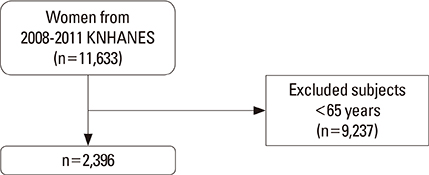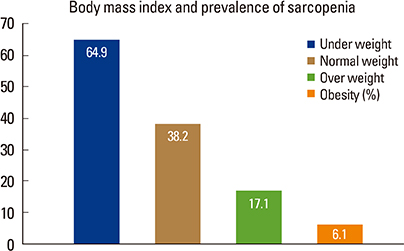J Bone Metab.
2018 Feb;25(1):53-58. 10.11005/jbm.2018.25.1.53.
Sarcopenic Obesity in Elderly Korean Women: A Nationwide Cross-sectional Study
- Affiliations
-
- 1Department of Neurology, College of Medicine, Kyung Hee University, Seoul, Korea.
- 2Department of Orthopaedic Surgery, National Medical Center, Seoul, Korea. hagine@nmc.or.kr
- KMID: 2406239
- DOI: http://doi.org/10.11005/jbm.2018.25.1.53
Abstract
- BACKGROUND
Sarcopenia causes loss of muscle mass in the elderly and is associated with development of metabolic syndrome in those with obesity. This study evaluated the prevalence of sarcopenic obesity (SO) in healthy Korean elderly women.
METHODS
This study was based on data from the Korea National Health and Nutrition Examination Survey IV and V, 2008-2011. Whole body dual energy X-ray absorptiometry and body mass index measurement were performed for all patients. Women aged 65 years or older were included in this study. Total appendicular extremity muscle mass was used to determine the skeletal muscle mass index.
RESULTS
Of 2,396 women aged 65 years or older, a total of 1,491 (62.2%) were underweight, normal weight, or overweight, while 905 (37.8%) were obese. The prevalence of sarcopenia using a cut-off value of 5.4 kg/m2 was 64.9% (63/97) in underweight women, 38.2% (320/838) in normal weight women, 17.1% (95/556) in overweight women, and 6.1% (55/905) in obese women.
CONCLUSIONS
The prevalence of sarcopenia was different among groups. The prevalence rate in obese women was lower than that in non-obese women. SO is a new category of obesity in older adults with high adiposity coupled with low muscle mass. The prevalence of SO was lower than that in previous studies because of differences in the definition. A consensus definition of SO needs to be established.
Keyword
MeSH Terms
Figure
Reference
-
1. Rosenberg IH. Sarcopenia: origins and clinical relevance. J Nutr. 1997; 127:990s–991s.
Article2. Visser M, Goodpaster BH, Kritchevsky SB, et al. Muscle mass, muscle strength, and muscle fat infiltration as predictors of incident mobility limitations in well-functioning older persons. J Gerontol A Biol Sci Med Sci. 2005; 60:324–333.
Article3. Xue QL, Walston JD, Fried LP, et al. Prediction of risk of falling, physical disability, and frailty by rate of decline in grip strength: the women's health and aging study. Arch Intern Med. 2011; 171:1119–1121.
Article4. Riechman SE, Schoen RE, Weissfeld JL, et al. Association of physical activity and visceral adipose tissue in older women and men. Obes Res. 2002; 10:1065–1073.
Article5. Baumgartner RN. Body composition in healthy aging. Ann N Y Acad Sci. 2000; 904:437–448.
Article6. Lim S, Kim JH, Yoon JW, et al. Sarcopenic obesity: prevalence and association with metabolic syndrome in the Korean Longitudinal Study on Health and Aging (KLoSHA). Diabetes Care. 2010; 33:1652–1654.
Article7. Choi KM. Sarcopenia and sarcopenic obesity. Korean J Intern Med. 2016; 31:1054–1060.
Article8. Zamboni M, Mazzali G, Fantin F, et al. Sarcopenic obesity: a new category of obesity in the elderly. Nutr Metab Cardiovasc Dis. 2008; 18:388–395.
Article9. Gregor MF, Hotamisligil GS. Inflammatory mechanisms in obesity. Annu Rev Immunol. 2011; 29:415–445.
Article10. Roubenoff R. Sarcopenic obesity: the confluence of two epidemics. Obes Res. 2004; 12:887–888.
Article11. Statistics Korea. Complete enumeration results of the 2016 population and housing census. 2017. cited by 2017 Aug 31. Available from: http://www.w3.org/1999/xlink" xlink:href="http://kostat.go.kr/portal/eng/press-Releases/8/7/index.board?bmode=read&bSeq=&aSeq=363132&pageNo=1&rowNum=10&navCount=10&currPg=&sTarget=title&sTxt=.12. Chen LK, Liu LK, Woo J, et al. Sarcopenia in Asia: consensus report of the Asian Working Group for Sarcopenia. J Am Med Dir Assoc. 2014; 15:95–101.
Article13. International Obesity TaskForce. World Health Organization. The Asian-Pacific perspective: redefining obesity and its treatment. Geneva, CH: World Health Organization Western Pacific Region;2000.14. Kim TN, Yang SJ, Yoo HJ, et al. Prevalence of sarcopenia and sarcopenic obesity in Korean adults: the Korean sarcopenic obesity study. Int J Obes (Lond). 2009; 33:885–892.
Article15. Hwang B, Lim JY, Lee J, et al. Prevalence rate and associated factors of sarcopenic obesity in korean elderly population. J Korean Med Sci. 2012; 27:748–755.
Article16. Kim YS, Lee Y, Chung YS, et al. Prevalence of sarcopenia and sarcopenic obesity in the Korean population based on the Fourth Korean National Health and Nutritional Examination Surveys. J Gerontol A Biol Sci Med Sci. 2012; 67:1107–1113.
Article17. Ryu M, Jo J, Lee Y, et al. Association of physical activity with sarcopenia and sarcopenic obesity in community-dwelling older adults: the Fourth Korea National Health and Nutrition Examination Survey. Age Ageing. 2013; 42:734–740.
Article18. Bouchard DR, Dionne IJ, Brochu M. Sarcopenic/obesity and physical capacity in older men and women: data from the Nutrition as a Determinant of Successful Aging (NuAge)-the Quebec longitudinal Study. Obesity (Silver Spring). 2009; 17:2082–2088.
Article19. Monteiro MA, Gabriel RC, Sousa MF, et al. Temporal parameters of the foot roll-over during walking: influence of obesity and sarcopenic obesity on postmenopausal women. Maturitas. 2010; 67:178–185.
Article20. Lu CW, Yang KC, Chang HH, et al. Sarcopenic obesity is closely associated with metabolic syndrome. Obes Res Clin Pract. 2013; 7:e301–e307.
Article21. Silva AO, Karnikowski MG, Funghetto SS, et al. Association of body composition with sarcopenic obesity in elderly women. Int J Gen Med. 2013; 6:25–29.22. dos Santos EP, Gadelha AB, Safons MP, et al. Sarcopenia and sarcopenic obesity classifications and cardiometabolic risks in older women. Arch Gerontol Geriatr. 2014; 59:56–61.
Article23. Batsis JA, Mackenzie TA, Lopez-Jimenez F, et al. Sarcopenia, sarcopenic obesity, and functional impairments in older adults: National Health and Nutrition Examination Surveys 1999–2004. Nutr Res. 2015; 35:1031–1039.
Article24. Aggio DA, Sartini C, Papacosta O, et al. Cross-sectional associations of objectively measured physical activity and sedentary time with sarcopenia and sarcopenic obesity in older men. Prev Med. 2016; 91:264–272.
Article25. Kwon HJ, Ha YC, Park HM. The Reference Value of Skeletal Muscle Mass Index for Defining the Sarcopenia of Women in Korea. J Bone Metab. 2015; 22:71–75.
Article26. Lee DC, Shook RP, Drenowatz C, et al. Physical activity and sarcopenic obesity: definition, assessment, prevalence and mechanism. Future Sci OA. 2016; 2:Fso127.
Article27. Dodds RM, Granic A, Davies K, et al. Prevalence and incidence of sarcopenia in the very old: findings from the Newcastle 85+ Study. J Cachexia Sarcopenia Muscle. 2017; 8:229–237.
Article28. Iannuzzi-Sucich M, Prestwood KM, Kenny AM. Prevalence of sarcopenia and predictors of skeletal muscle mass in healthy, older men and women. J Gerontol A Biol Sci Med Sci. 2002; 57:M772–M777.
Article29. Lainscak M, von Haehling S, Doehner W, et al. The obesity paradox in chronic disease: facts and numbers. J Cachexia Sarcopenia Muscle. 2012; 3:1–4.
Article
- Full Text Links
- Actions
-
Cited
- CITED
-
- Close
- Share
- Similar articles
-
- Resistance Exercise Strategies for Sarcopenic Obesity in Elderly People
- Physical Activity and Sedentary Behavior Patterns according to Body Composition Phenotypes of Sarcopenia and Obesity in Frail Older Women
- Prevalence and Factors Related to Sarcopenic Obesity among Community-dwelling Elderly Women
- Relationships among Obesity, Sarcopenia, and Osteoarthritis in the Elderly
- Effects of sarcopenia and sarcopenic obesity on joint pain and degenerative osteoarthritis in postmenopausal women



